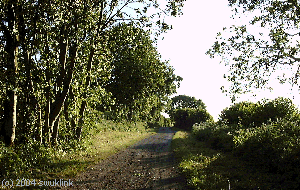As the last ice age relinquished its grip on the British Isles some ten or twelve thousand years ago, the tundra the receding ice sheets revealed was colonised by forests. First by birch, and later by the mixed decideous woodland with which we are now familiar. In England, this climax vegetation (the natural vegetation of an area) of decideous woodland stretched from coast to coast, brocken only by rivers, lakes and mountains.
The people of the Stone Age who inhabited the British Isles lived by hunting and fishing and roamed the country in search of their prey. About 3,500 BC, the first farmers arrived in the British Isles from continental Europe. They settled on the chalk uplands such as Salisbury Plain and the Marlborough Downs where the cover of woodland was lighter than in the densely wooded lowlands and, working with flint axes and antler picks, made clearings in the woodlands in which they lived and cultivated their crops. Their sheep and cattle which grazed the land kept the clearings open, preventing the growth of scrub and recolonisation by woodland.
When the soil in their clearings was exhausted, these early farmers and their livestock moved their settlements to new areas of woodland trampling pathways through the landscape as they went. Over time, a network of pathways covered the chalklands of southern England used for occassional migrations and regular trade. The Ridgeway ran from East Anglia, through what was to become Wessex, down to the English Channel on the Dorset coast. By the Bronze Age (c.2,300-c.750BC), The Ridgeway had become an important route between Southern England, Yorkshire, Ireland and the continent with the merchants that travelled along it trading in implements, gold and copper weapons. Later the trade became more extensive; jet from Yorkshire, amber from the Baltic and blue falence beads from Egypt all made their way along The Ridgeway.
Late in the 8th century BC, the Celts arrived in the British Isles, bringing not only the superior weapons wrought from iron which gave the "Iron Age" its name, but also improved farming methods from the European mainland. The Celts preferred to avoid the dense woodlands of the valleys as well and they too made their homes on the chalk highlands.
These early upland tracks continued to be used throughout the Iron Age and the subsequent Roman occupation. It was only with the arrival of the Saxons after the Romans withdrew from the British Isles in 410 that they were abandoned as the new settlers established villages and field systems in the river valleys.
|
| | | Links to Other Pages on this Site
|
| |
| | |
|
| | | Links to Other Sites
|
| |
| | |
Recommend a Book for this Page
Hits on this page since December 6th| Jan | | | | | Feb | | | | | Mar | | | | | Apr | | | | | May | | | | | Jun | | |  | | Jul | | |  | | Aug | | |  | | Sep | | |  | | Oct | | |  | | Nov | | | | | Dec | | |  |
current year:  | | previous year:  |
No messages posted on this page Only Members of the Site can post messages in this section. Signing in is easy from our Home Page. DISCLAIMER: Whilst we endeavour to ensure the content of this site is correct, we cannot undertake that information you find here, is, or will remain accurate and complete. We do not warrant that any information contained on this site is fit for any purpose. If you wish to place reliance on any such information you must check its accuracy by some other means before doing so. MEMBERS get aditional features on our pages and will soon be able to interact with the site and add their views and informastion. Sign up, from the Home-Page, is simple and involves typing in your email address and a password of your choice. If you are in any way connected with any location or interested in the subject mentioned on this page and have an hour or two a month to spare, we would welcome you as a local moderator - please email the webmaster by CLICKING HERE. Privacy Policy
|
|







